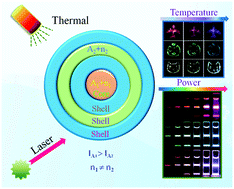Manipulating the upconversion (UC) emission color by externally applied fields allows access to a range of novel applications. Although such controls based on the multi-color UC nanocrystals (NCs) have previously been reported, it is still a challenge to construct a multi-mode responsive system that can enable multifunctionality within one single nanostructure. Herein, an integrated core/triple-shell nanostructure, in which the different activators are spatially separated, is applied for a dual-mode manipulation of the UC emission color. The 3-photon dominant UC emission intensity of the Tm3+ ions is enhanced more than that of the 2-photon counterpart of the Er3+ ions by increasing the excitation power, leading to an excitation power induced color variation. Moreover, the UC emission intensity of the Er3+ activators in the core exhibit a thermal quenching effect, while that of the Tm3+ ions in the second-shell show near-zero thermal quenching in the visible region, which contributes to the temperature dependent color change. Upon tuning the emission color by means of appropriate co-doping in the core, a series of power/thermal dual-mode responsive multi-color UC NCs are achieved, which endows the UC nanostructure with a bi-functionality that can find potential applications in temperature sensing and anti-counterfeiting fields.
